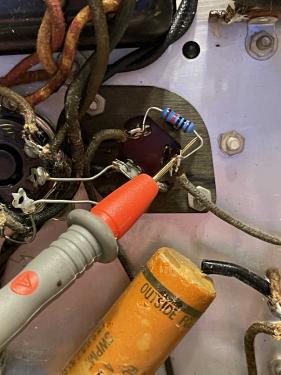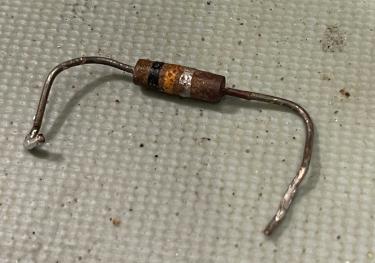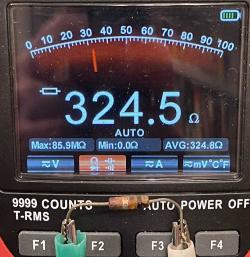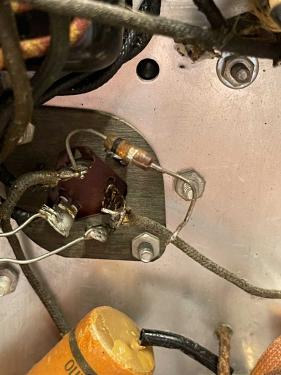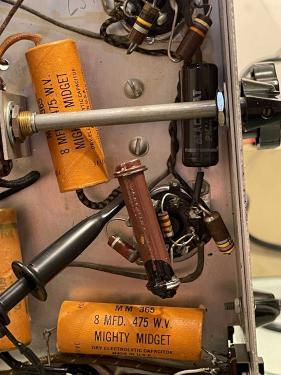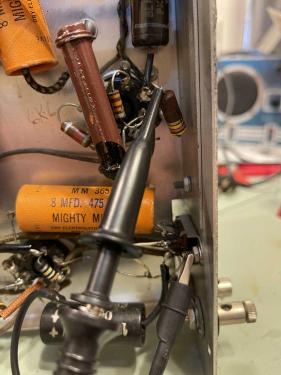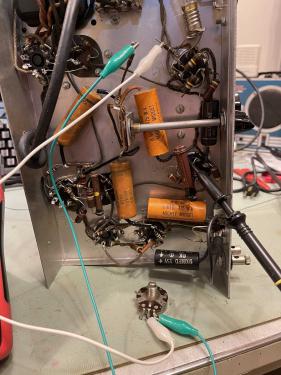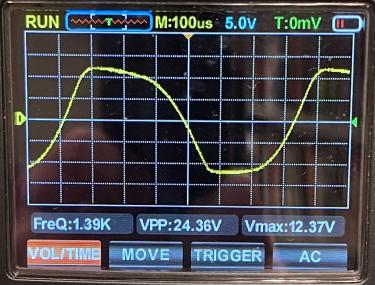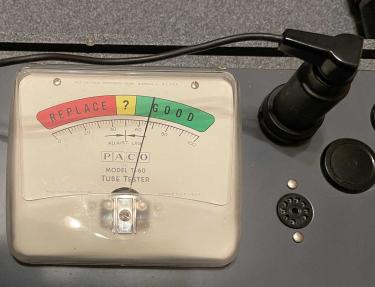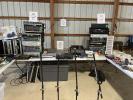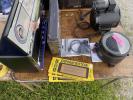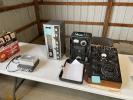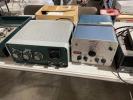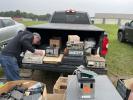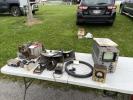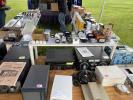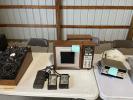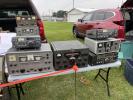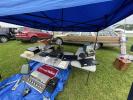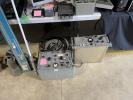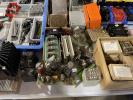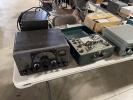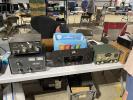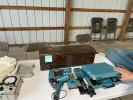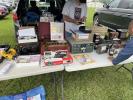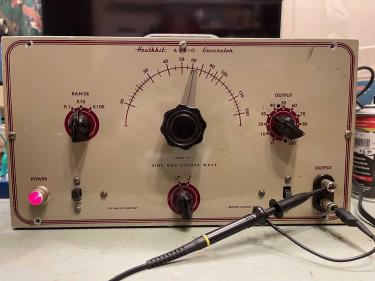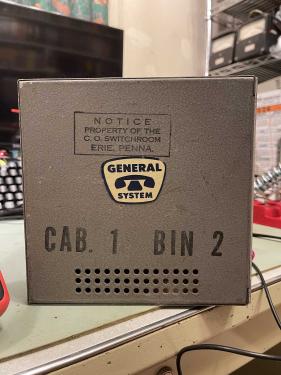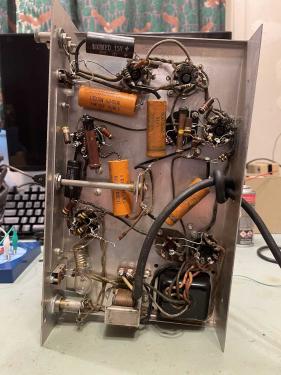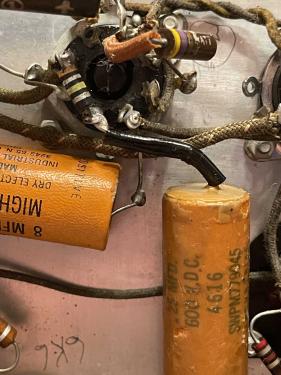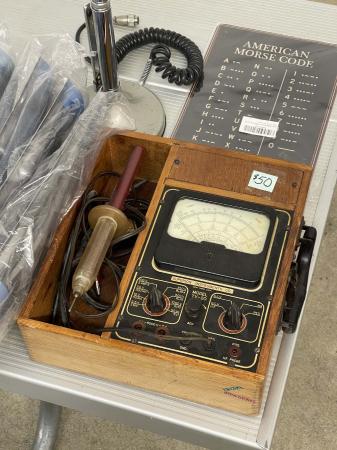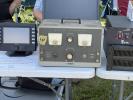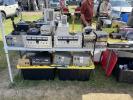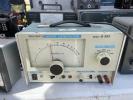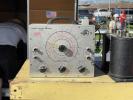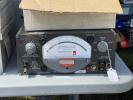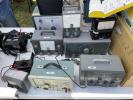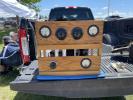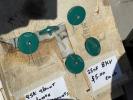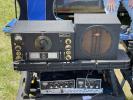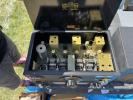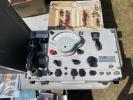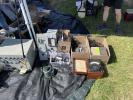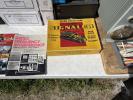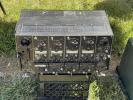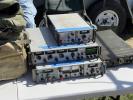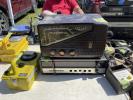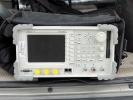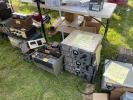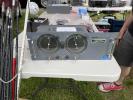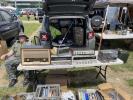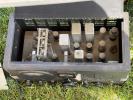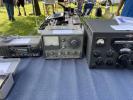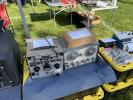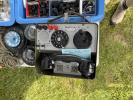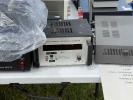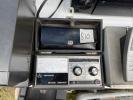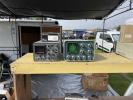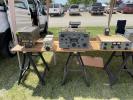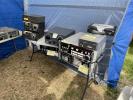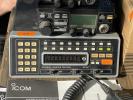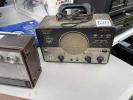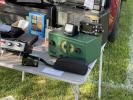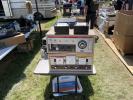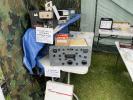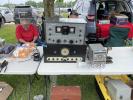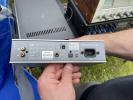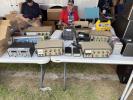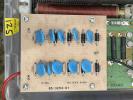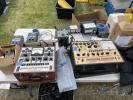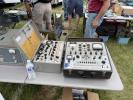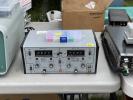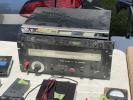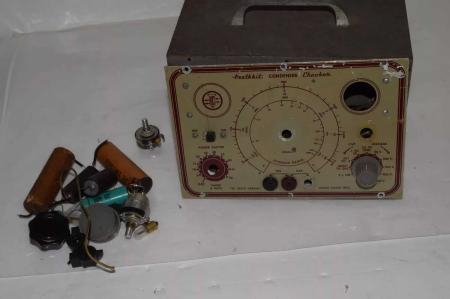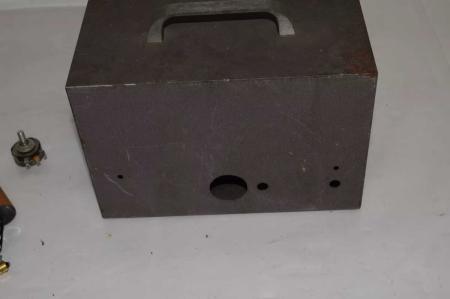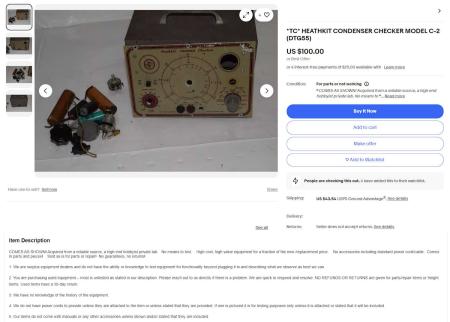- 2025
- Jun
- 18
The Heathkit AG-7 Audio Generator part 4: Repairs
In the last post, something went bad in the oscillator portion of the Heathkit AG-7.
There were other things wrong as well, if they were caused by or were pre-existing to this failure, I don’t know. But one of those was easy to fix, that of the 10kΩ resistor in the power supply. This resistor decided it was going to be about ~300Ω or so, and had to go. Fortunately, I had some spare 2W units from a previous rebuild project, and put one in.
That, unfortunately, didn’t fix the issue. Since everything else seems to be mostly ok, I have to assume that I damaged the tube(s) during my testing of the device, or the incorrect power supply voltages damaged the tubes and it was just coincidence that it failed when it did.
Therefore, this unit gets set aside until I can replace the two oscillator tubes, verify it works, and rebuild the unit.
In the meantime, here’s the 10kΩ that was removed.
It looks pretty crusty at this point. Not sure what cause it to short.
But short (relatively) it did:
This one goes in my bin of oddball parts for later fun.
Next part of this series: https://wereboar.com … nna-need-everything/
Previous part of this series: https://wereboar.com … or-part-3-diagnosis/
- 2025
- Jun
- 11
The Heathkit AG-7 Audio Generator part 3: Diagnosis?
When the AG-7 quit, I wasn’t really sure what caused it except that the oscillator now won’t. Tubes check fine on my cheapie tester, so I decided to start doing some measurements around the 6J7.
These didn’t seem right, much higher than they should be, but the individual components were (mostly) within tolerance after disconnecting from the circuit. It still didn’t seem right, things were bouncing around like there was another path to the filters.
I disconnected the line from the filter and that all went away. Ok…do I have a bad filter capacitor now? No, it checks ok, but that’s with the 10kΩ resistor across the filter disconnected.
And there it is. The 10kΩ resistor that goes from triangle to dash on the filter is bad. It’s not open, or high resistance, it’s 295Ω. Confirmed this with two meters…what? I’ve never had one of these old carbons short like this, but I suppose it’s completely plausible. It is 70ish years old at this point.
I have plenty of 10k resistors laying around to test with, so I’ll take some time and see if that gets me back to a semi-working condition so I can complete my troubleshooting from the last problem. I suspect this is going to need a complete rebuild in order to be functional with any kind of reliability…
Next part of this series: https://wereboar.com … ator-part-4-repairs/
Previous part of this series: https://wereboar.com … ator-part-2-testing/
- 2025
- Jun
- 10
The Heathkit AG-7 Audio Generator part 2: Testing
In the last post, we determined that this device was mostly operational, but had one of the problems you see with Wein bridge oscillators - one side of the output signal was clipped. That can be an issue with not enough or too much drive in the feedback circuit, so I decided to do some tests.
Here’s the schematic for this device:
An oscillator is an amplifier that provides it’s own input. You’ve probably run across that with feedback on a public address system - that’s the amplifier becoming an oscillator.
In this case, it’s controlled oscillations that we’re looking for. To do this, this particular oscillator model provides two kinds of feedback. Positive feedback, which is the actual oscillator drive and is controlled by the frequency selection capacitors and resistors. And, negative (servo mechanism) feedback that is provided by a lamp used as a positive temperature coefficient resistor - that is, the more current the circuit tries to draw, the more the lamp resists that and tries to keep the gain stable.
The reason you need the servo mechanism is because the oscillator will continue to draw more current until it reaches the limit it can draw from the supply - and probably clip and/or destroy things. The lamp is a quick and easy way to stop that, and was used in almost all oscillators of this type. Later ones used an FET or other current control method, and modern DDS generation doesn’t need this.
Before I tried anything, I swapped the bulb with a new one. No change there.
I’m going to start with checking the oscillator and feedback loop to see if the distortion is present in the oscillator. Pin 3 of the 6k6 Pentode is the output amplifier for this part of the circuit, so checking on Pin 3 should reveal most of what we need to know:
And the distortion is there, so we can probably assume that it’s present in the whole circuit.
(The schematic doesn’t show the suppressor grid - Grid 3 - on the 6K6, but it’s there. It’s tied to the cathode internally, so some manufacturers didn’t show it since you couldn’t access it.)
So that means the input to the 6J7’s control grid is probably distorted as well.
It is.
So it follows that the input to the 6K6 is also bad.
It is, and it’s quite high - perhaps this needs to be cut down some? (It’s inverted because each stage acts like an inverting amp, so the distortion is at the top now.)
Before moving on to the interconnect between the two stages, I decided to examine the feedback loop. Breaking the two resistors, I put a potentiometer removed from the Heathkit AF-1 in-between the stages.
Interesting - more resistance caused the device to go into severe clipping:
Less resistance did nothing much. One thing I did notice is that too much resistance will cause the oscillator to become unstable - this explains the problems I’m seeing with the BW200 oscillator that was on the bench recently.
I was going to move on to the interconnect between the stages (plate of the 6J7 to the control grid of the 6K6) but something happened. I had no output at all, and I’m not sure what happened. Did something pop, like one of the capacitors? The tubes seem to check good:
I need to do some more checking on this thing before making my decisions about what’s going to happen to it.
Next part of this series: https://wereboar.com … or-part-3-diagnosis/
Previous part of this series: https://wereboar.com … part-1-observations/
- 2025
- Jun
- 8
Photos from the 2025 Breezeshooters Hamfest.
Unlike last year, this year was promising rain - we could see it coming on the RADAR feed, but thought it would hold off for a few hours.
…but it didn’t hold off for long. We got about an hour before it started raining. Not hard, just a summer shower, but it wasn’t going to let up. We headed out.
The threat of rain kept a lot of vendors away, as the outdoor part of the market was less than half of last year’s crowd. That’s just the way this works - sometimes it rains. Still, there was a decent amount of things to see and the indoor portion of the show was full. Prices on some of the things was kind of high, with a few of the things I saw being just crazy - they were stopgap hobby things when new, and they aren’t aging well. Still, if someone is willing to pay it then more power to the people selling.
I did pick up a nice metered GenRad variac for $10, and some old Rat Shack style protoboards for a couple bucks each. I was offered some other things really cheap, but the “I don’t need more of this stuff” mentality kicked in.
Here’s what I saw at the show:
.
This finishes shows for the first half of the year, as there aren’t any I’m going to attend in July. Next is the Aladdin Shrine Audio Unit show in Columbus, Ohio, followed by the Cincinnati Hamfest in (obviously?) Cincinnati, Ohio.
See you there!
- 2025
- May
- 30
The Heathkit AG-7 Audio Generator part 1: Observations
If you’ve been reading this site, you’ve probably seen this guy. It’s a Heathkit AG-7 Audio Generator that was purchased at the Breezeshooters Hamfest in Butler, PA during their 2023 event. It’s not something I needed, but was interesting because it had a decal from General Telephone’s Erie, PA office, and had drill points that looked like it had been set-and-forget. Some sort of tone generator for the telephone switch, perhaps? I’m not sure, save that this device has some interesting history behind it.
Here’s the decal on the side:
The chassis shows some signs of work over the years. J-hooked parts show someone probably did some investigative repairs, and that resistor pair that’s tied together certainly wasn’t factory…
What’s the initial diagnosis here?
Power supply seems to be working, and filter capacitors aren’t dried out. They’re not getting hot and nothing else is smoking.
The device has an output:
You can see this device has the same issue that a lot of Wien bridge oscillators have - the lower half of the signal is partially cut off. Later devices took care of this by putting adjustments in the oscillator circuit itself, but this one didn’t have that:
So there’s probably some resistors that have drifted in the oscillator circuit itself. No surprise there, and the repairs are going to be the first suspect.
It does have another, less apparent issue - the oscillator will stall and restart when you rapidly change the dial. There are trimmers in the unit to help alleviate this, and an adjustment procedure for them. This isn’t really that big of an issue, so I’m not concerned with it right now. The main thing is going to be figuring out which parts needs to be adjusted to bring this device back to a pure sine wave, at which point a partial or full rebuild may be in order.
Next part of this series will be determining where the sine goes bad. Stay tuned!
Next part of this series: https://wereboar.com … ator-part-2-testing/
Original post: https://wereboar.com … -7-signal-generator/
- 2025
- May
- 24
Photo(s) from the 2025 SVARC Hamfest
As expected, this was a tiny show and had maybe a dozen vendors show up. I didn’t see a whole bunch of stuff I was interested in, mostly some nice radio gear and some electronics flea market stuff. Nothing really photo worthy except this interesting meter:
If it had been cheaper I would have bought it for the probe. $50 was just too much for something I wasn’t going to use much.
I did pick up a bunch of parts, so I’m happy with the trip.
Nothing wrong with stocking your parts bin with things.
Next show is Butler, see you there!
- 2025
- May
- 21
The 2025 Breezeshooters Hamfest - June 8th 2025
This is a decent size local show that happens in Butler, PA at the Butler Farm Show event ground. I can usually spend 2-3 hours here, as they have several outdoor and indoor market spaces set up. It’s worth the trip if you’re in the surrounding area.
This is usually one of the first “Dayton Items without the Dayton Prices” shows that I’ll attend. See you there!
Breezeshooters Hamfest
Butler, PA
Butler Farm Show
625 Evans City Rd
Butler, PA 16001
June 8
8A - 2PM
https://breezeshooters.org/ns/hamfest/
We usually end the trip with a lunch at the Monroe Hotel Restaurant in Butler.
- 2025
- May
- 19
Saturday’s photos from the 2025 Dayton Hamvention.
Saturday turned out to be a sunny, cool, and quite breezy day at the show. It looked like a few vendors left, and a few new ones showed up with stuff being unpacked throughout the day. We took a second tour of the flea market and looked inside one of the exhibit halls - things were just too packed in there to worry about.
I didn’t take home much this day - some parts and a couple of books.
Here’s what I saw on Saturday:
.
I decided to skip out on Sunday, as I’d already seen everything twice and just didn’t feel like walking more.
Next up is SVARC in Piketon, and then Breezeshooters in Butler, PA. See you there!
Friday’s Pictures: https://wereboar.com … 5-dayton-hamvention/
Saturday’s Pictures: https://wereboar.com … 5-dayton-hamvention/
Sunday’s Pictures: Didn’t make it back on Sunday.
- 2025
- May
- 19
Friday’s photos from the 2025 Dayton Hamvention.
Friday started out to be a nice day, quickly turned angry looking, and remained there for the rest of the day. It was threatening rain, but that all went to the south of the show during the day, and we had a relatively cool, slightly breezy afternoon for browsing the aisles.
This year was more of a “ham radio” year than previous. Yes, this is a radio show, but a lot more rigs and things seemed to show up. One of the vendors stated “Yes, that’s because everyone is dying,” and the older crowd we observed (myself included) seemed to indicate that more of the same would be happening. That’s probably where my stuff will end up in 30 years…
There was still a lot of good stuff to see, although I didn’t find what I was looking for. I did manage to drag a few things home, and overall had a good time.
This is what I saw on Friday:
.
I did go back on Saturday, so check the next post for those pictures.
Friday’s Pictures: https://wereboar.com … 5-dayton-hamvention/
Saturday’s Pictures: https://wereboar.com … 5-dayton-hamvention/
Sunday’s Pictures: Didn’t make it back on Sunday.
- 2025
- May
- 14
Crap from eBay #2 - “High cost, high value”
Here’s a Heathkit C-2 “Condenser Analyzer” for sale. It’s listed at $100 with almost $44 in shipping.
For some reason, capacitor analyzers of this nature have become the hot thing. It’s in part due to the glowing green magic eye tube that these used as their primary output display indicator, but also (I’ve been told) people use these and their high-voltage outputs to “reform” old capacitors for reuse. Why? I guess because the Internet told them that old=good, new=garbage.
You’ll notice this thing is in fairly poor condition. It has a pile of parts included with it. Some of them obviously came from the device. Some did not. All of them had to be cut out of circuit in order to be in this pile. It looks like someone just grabbed a handful of things nearby and added them to the image.
These devices were a very simplistic variant of the capacitor checker, and had a small chassis at the top that contained the power and eye tube circuitry. It appears to still be there by the screws in the panel, but that’s about it. The eye tube is missing. Two of the three controls are missing (are they in the pile?) The leakage lamp is gone, and the panel is, overall, in poor condition. We can’t see the chassis itself anywhere so there’s no guarantees that anything other than the metal is still there. Even that is suspect!
The front panel is in poor condition, but the case is in just as bad of condition. It’s intact, but rusty. The handle is still there, which is good, but that’s about it. No power cord is present, so it’s probably been cut off for some reason.
If I were to see this at a hamfest, it would probably be in the dollar box, or even the “free” box. I’d take it for a buck to get the aluminum handle and knob and dump the rest in the trash on the way out. This, in my opinion, is certainly not $144.00 worth of anything.
The good part is the description:
There’s our images again. You can plainly see they aren’t showing a chassis here, even though all of the screws are missing and it would be easy to do so. Why not? Why show the pile of parts close up but not the chassis?
But as stated, the description is pure gold.
“Acquired from a reliable source.” What’s that supposed to mean?
A “High end hobbyist private lab.” If this is the case, then this was in their junk bin.
“No means to test.” No kidding. Really? The exploded view is laying on the bench, exploded.
“High cost, high value equipment for a fraction of the new/replacement price.” Again, what is this supposed to mean? I can get a brand new device that does everything but leakage for $25, with the added bonus of testing every other common part as well.
(Leakage is not necessarily as useful as it seems. These devices were designed to test paper, mica, and electrolytics of the 1940s-1960s. Chances are, all of those old paper and electrolytics are bad and will get replaced regardless, so who cares if they leak? They need to be replaced.)
Much of this listing is boilerplate from the seller, and they use it in all listings. But some of it, in my opinion, is deliberately playing on a potential buyer’s desire to own one of these, even if they don’t fully understand the device. While I have no problem with selling this device itself (I used to sell used and parts-only things on eBay years ago) this device is (again, my opinion only!) being deliberately puffed up in order to make it appear it’s something it’s not. I don’t know if this is malicious or if it’s just the seller’s lack of knowledge - but with the other things seller has listed I think I’d be well within rights to assume they have some knowledge of this device.
Of course, it’s buyer beware on eBay, but still. Treat your customers with a little respect here. You got junk, sell it at a junk price!
If you do want one of these, there are several examples of the better C-3 device available, for substantially less than this one. Many of those are demonstrated working.
This one is here because the seller seems to be playing on the desire for this kind of device, even though the example they have will probably never be operational again.
Buyer beware!
